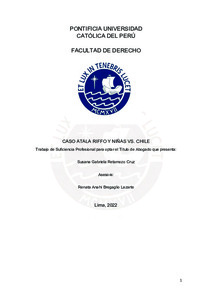El sistema se apagará debido a tareas habituales de mantenimiento. Por favor, guarde su trabajo y desconéctese.
Caso Atala Riffo y niñas vs Chile
Abstract
El objetivo general del presente informe jurídico es analizar la sentencia emitida por la
Corte Interamericana de Derechos Humanos (Corte IDH), en el caso Atala Riffo y niñas
vs. Chile. Se elige esta sentencia debido a que es el primer caso en el que el
mencionado Tribunal utiliza la categoría “orientación sexual” como un criterio protegido
por el artículo 1.1. de la Convención Americana de Derechos Humanos (CADH) y, como
tal, es la resolución que da inicio a su ya abundante jurisprudencia en materia de
protección de los derechos humanos de las personas LGBTI. En esa línea, en atención
a lo sucedido con la señora Atala Riffo e hijas, la Corte IDH resalta la trascendencia del
principio de igualdad y no discriminación, para la aplicación efectiva de los derechos
contenidos en la CADH, tales como la igualdad ante la ley, la vida privada y familiar, las
garantías judiciales y la protección específica de las niñas y niños. Es por ello que, a
manera de conclusión, se sostiene que en el Sistema Interamericano de protección de
los derechos humanos: (i) es abierta la lista de categorías protegidas por el mandato de
no discriminación, (ii) que la aplicación de la ley no debe dar lugar a diferencias de trato
motivadas en la orientación sexual, (iii) que la orientación sexual de la madre o del padre
no es relevante en un proceso de tenencia, ni en un proceso disciplinario, y (iv) que el
derecho humano de las niñas y de los niños, a ser oídos en todo asunto que les afecta,
está debidamente protegido por los artículo 8.1 y 19 de la CADH. The main objective of this legal report is to analyze the Inter-American Court of Human
Rights’ sentence in the case Atala Riffo and Children vs. Chile. This sentence was
chosen because it’s the first case in which the Court uses the category “sexual
orientation” as a criterion protected by article 1.1 of the American Convention on Human
Rights. That resolution began the already abundant jurisprudence on protecting LGBTI
people’s human rights. In response to what happened with Mrs. Atala Riffo and her
daughters, the Inter-American Court highlights the importance of the principle of equality
and non-discrimination for the effective application of the rights contained in the
Convention, such as equality before the law, private and family life, judicial guarantees
and the specific protection of children. In conclusion, it’s argued that in the Inter-
American System for the protection of human rights: (i) the list of categories protected
by the non-discrimination is open, (ii) the application of the law shouldn´t give rise to
differences in treatment based on sexual orientation, (iii) the sexual orientation of the
mother or father is not relevant in custody or disciplinary processes, and (iv) the human
rights of the children, to be heard in all matters that affect them, is duly protected by
articles 8.1 and 19 of the Convention.
Temas
Corte Interamericana de Derechos Humanos--Jurisprudencia
Menores--Protección--Chile
Discriminación sexual--Legislación--Chile
Menores--Legislachión --Chile
Menores--Protección--Chile
Discriminación sexual--Legislación--Chile
Menores--Legislachión --Chile
Para optar el título de
Abogado





